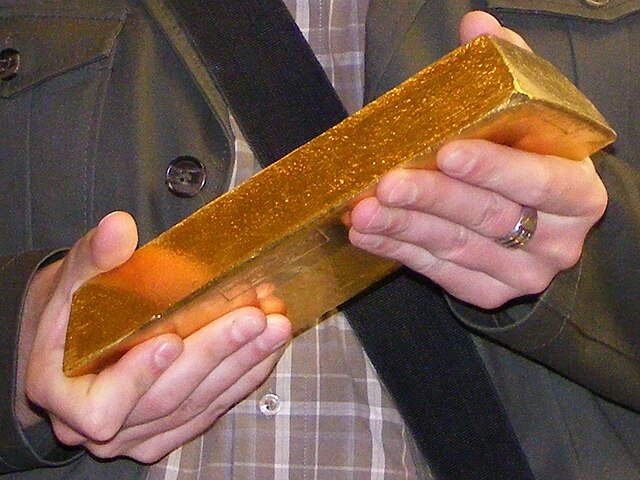One time-tested and reliable way to invest in precious metals is with gold bars, also known as gold bullion. Gold bars are safe and stable, and they can diversify portfolios and protect against economic fluctuations. That is why gold bars are the best way to preserve one’s wealth since nothing is more secure in an unpredictable world. With increasing risk and economic instability, fixed investments such as equities and bonds are comparatively riskier. Therefore, going for gold can avoid these pitfalls and serve as portfolio insurance.
But educate yourself on gold bars before you put your money into them.
If you have ever been intrigued by their nature, you have come to the right place. It is now time to learn all you want to know about the world of gold bars before you start this precious metal investment.
Introduction
A gold bar is a cake-shaped product made of gold that can reach a density of up to 99.99%. It comes in different weights and sizes, allowing investors to meet various requirements. It is manufactured by private refineries and sovereign mints. Larger bars are usually made by pouring liquid gold into molds, while smaller bars are made by special heavy machinery.

Gold bars serve multiple purposes: as Individuals’ wealth entities, bank funds instruments, and international currency. Today, they mainly act as a long-term store of value, which can provide reasonable protection against inflation and other risk factors.
What is investment-grade gold?
Investment gold is a variety of gold products with the highest purity possible. It usually contains 99.5% or more pure gold. Refiners then carefully process these metals into gold bars or coins for immediate sale in the market.
There is an investment-graded gold in several weights targeting various investors with distinct needs and goals.
Popular weights include:
- Single-Ounce Bars
- Ten-Ounce Bars
- 5 gram Gold Bar
- Single-Kilo Bars
- 400-Ounce Bars
Numerous mints worldwide stamp and sell investment-grade gold, ensuring a relatively uniform standard in terms of content and appearance across products. One popular example is Perth Mint gold bars.
How to Identify Investment-Grade Gold Bars
It is easy to seek out investment-quality gold bars. To be considered investment bars, such bars must meet set parameters about their shape, weight, and purity. Key identifying features include:
- The name and logo of the sovereign mint or refining company.
- A serial number for further protection and identification on the larger bars.
These features play a critical role in discouraging counterfeiting and guaranteeing the legitimacy of gold bars. Reputed mints and refineries maintain high standards, and their gold bars easily pass through the international market.
Some of the world’s most renowned mints and refineries include:
- Argor Heraeus
- Credit Suisse
- Johnson Matthey
- Metalor
- Perth Mint
- Royal Canadian Mint
- Valcambi
How Much Does a Gold Bar Weigh?
A standard gold bar varies in size from one gram (approximately 0. 032 troy ounces) to 15 kilograms (400 troy ounces). The list of the most oversized gold bars also includes a 250 Kg (551 lb) gold bar worth over $18.91 Million.
Some popular weights are:
- 1 oz Gold Bars
- 10 oz Gold Bars
- 100 oz Gold Bars
- 400 oz (London Good Delivery Bars)
- 1 Gram Gold Bars
- 2 Gram Gold Bars
- 2.5 Gram Gold Bars
- 5 Gram Gold Bars
- 10 Gram Gold Bars
- 50 Gram Gold Bars
- 100 Gram Gold Bars
- 500 Gram Gold Bars
- 1 kilo Gold Bars
How Much is a Gold Bar Worth?
The price of a gold bar depends on the spot price of gold at the time of purchase and the premium charged for the particular type of gold bar. Both the buyer and the seller should understand such dynamics.
- Gold Spot Price: Real gold is traded in Troy ounces, and its price fluctuates at a given moment depending on the supply and demand situation in the wholesale market.
- Gold Content: The value of a gold bar is determined by the following formula: the number of troy ounces of pure gold multiplied by the gold spot price per troy ounce.
- Investor Demand: Gold bars are affected by demand factors such as the state of economic and geopolitical affairs and investment outlook, among other demand motives that determine the price and premiums of the bars.
- Weight: Gold is quantified in forty ounces, slightly heavier than average. A 1-kilo gold bar contains about 32.1507 troy ounces of gold.
In addition to the spot price, a gold bar is offered at an additional price to afford production, marketing, and distribution costs.
Are Gold Bars a Good Investment?
For experienced and big investors, the bars are the most effective form of gold investment as they are usually cheaper in premium-based calculation. However, there is a flip side to the bigger bars; they are not as saleable as the smaller ones.
Gold offers an element of reassurance that few other investments can, especially when the economic slump is a looming concern. In contrast, gold rises in value over stocks and bonds during emergencies and critical situations like inflation or fluctuations in the stability of a currency. Market trends show that gold value has been rising during crises, for example, during the COVID-19 pandemic of 2020 and when the Russian invasion of Ukraine began. It further shows why gold is resistant to a fall during crisis periods and while other assets may decline in value.
Where to Buy Gold Bars?
Making the right decision to purchase gold bars is critical to managing your portfolio. Where you get them affects not only your current purchase but also your overall investment plan.
- High-Street Stores: Unlike internet-based shops, local stores are convenient and allow customers to easily come in, inspect, and take home gold bars. However, they may not offer affordable premiums or attractive professional storage options that prominent bullion dealers do.
- Online Marketplaces: It is essential to note that while there is a vast assortment of gold bars on the internet, some sellers may not guarantee the legitimacy of offered products or provide trustworthy buy-back terms for investors. You check marketplaces like eBay.
- Dedicated Gold Bullion Dealers: The reliable dealers focus on safety, convenience, and customization. Regarding gold bars, dealers like BOLD Precious Metals, Apmex, etc., have a unique selection for all types of investors, affordable premiums, and a clear buy-back policy. Some dealers even have storage solutions for their buyers!
How to Buy Gold Bars?
When purchasing gold bars, several critical factors should guide your decision-making process: When purchasing gold bars, several critical factors should guide your decision-making process:
- Range of Gold Bars and Products: Some companies deal with a restricted number of gold bars, which may present a constrained selection of the items suited to certain portfolio demands or price ranges.
- Premiums Charged: The premium, also an extra amount charged on top of the gold price, covers costs such as procurement, administration, and promotion. The price difference between a smaller gold bar and a bigger one is that premiums are generally higher on smaller gold bars.
- Additional Charges: Other factors affecting the cost of acquisition from dealers include delivery, insurance, and handling.
- Storage Options: After the purchase, you can store the bars at home or in a storage area offered by the supplier.
- Buy-Back Options: Holding physical bars is useful to diversify the portfolio, but being able to sell these bars back at a low cost with efficiency is necessary to manage exposure or liquidate profits.
- Reputation: Evaluating the vendor’s credibility through client ratings, references, recommendations, and other web reviews provides reliability and quality of the services offered.
These factors collectively enable competent decisions, regarding the agreement of gold bar purchases with worthy objectives, mutual possessing security, and adequate essential portfolio variability for your needs.

Start Investing in Gold Bars- Takeaways!
Some key factors to consider when investing in gold bars include their purity, associated premiums, and divisibility.
Here are some key takeaways:
- With purity exceeding 99.5%, investment-grade gold derives its value from the international spot price.
- Bars incur a premium covering manufacturing and distribution costs, typically lower for larger bars due to economies of scale.
- Since smaller bars or coins can easily be subdivided, they can be sold proportionately when needed, whereas in larger bars, the whole unit has to be sold.
- A professional vault provides secure storage and efficient selling mechanics.
Hopefully, this information will guide you well in your investment journey!
Also, Read The Following: Bank transfer euro card.









